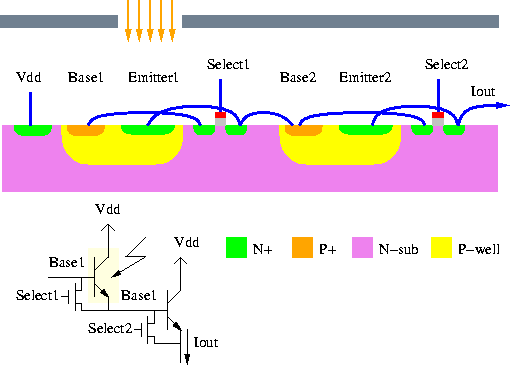The sensitivity of a photodiode as derived in
section 7.2.1 can only be changed by the applied
voltage across the diode. The relationship between the output
photocurrent and the voltage across the diode is ![]() . This amount of controllability is certainly not enough for
practical applications. A structure that can result in several orders
of magnitude of adaptation is the multisensitivity sensor presented in
section 2.17, shown again in
Figure 7.41. Using this structure the
dynamic range can almost be tripled. For low light levels the
darlington pair provides a high current gain. For mid levels only one
bipolar transistor is activated, and for high light levels both
bipolar transistors are inactivated.
. This amount of controllability is certainly not enough for
practical applications. A structure that can result in several orders
of magnitude of adaptation is the multisensitivity sensor presented in
section 2.17, shown again in
Figure 7.41. Using this structure the
dynamic range can almost be tripled. For low light levels the
darlington pair provides a high current gain. For mid levels only one
bipolar transistor is activated, and for high light levels both
bipolar transistors are inactivated.
The signal to noise ratio for all three configurations remain almost the same. Of course, the current levels at the output will be in a more manageable range for handling by subsequent circuits.
The variable sensitivity photodetector (VSPD) mentioned in section 5.1 also provides a mechanism which controls the sensitivity of the photodetector. The VSPD which is similar to the structure shown in Figure 7.1-e provides a linearly controlled sensitivity by the voltage applied across the photodetector.

Figure 7.41: Ward-Syrzycki's multisensitivity photodetector.